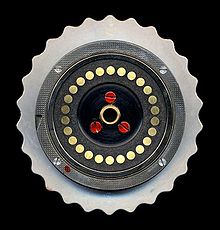RM-26
RM-26 , also spelled RM26 , RM 26 or RM (26) , was the name of a British rotor cipher machine from the late 1940s. The abbreviation possibly stood for Rotor Machine 26 letters ( German "26-letter rotor machine" ).
history
Shortly after the end of World War II, the then decided to coordinate the cipher competent body , the British Cypher Policy Board (CPB) , German " cipher - guidelines committee '' , a new and cryptographically highly secure cipher to be developed. The purpose was to obtain a modern replacement for the Combined Cipher Machine (CCM) used in the war and now no longer considered up-to-date, and thus to get a successor to the TypeX Mark 23 used on the British side .
The English mathematician and cryptanalyst Gordon Welchman (1906–1985), inspired and supported by his compatriot and colleague Alan Turing (1912–1954), then devised a kind of “British Enigma”. It was a rotor machine, similar to the German Enigma machine from the Second World War, which, however, was much more complex due to the significantly higher number of rotors and was therefore considered to be significantly more burglar-proof . Instead of only three or four rotors contained the RM-26 is not less than twenty-four (24) Drums ( German literally "drums" ), which were arranged in three separate "banks" to eight rotors. These corresponded to the " rollers " of the German machine and, like them, had 26 contacts on each side (picture) , with each contact being assigned one of the 26 capital letters of the Latin alphabet (A to Z). Each contact on one side of a rotor was connected by an insulated wire inside in an irregular manner to a contact on the other side of the rotor. In contrast to the Enigma, where the rollers were wired differently, all rotors of the RM-26 have the same (irregular) wiring. The rotors are switched on using a gearbox . This enables some rotors to even turn backwards.
The implementation of the devised by Turing and Welchman concept was done in 1947 by the Canadian engineer Benjamin DeForest Bayly (1903 to 1994), who a few years earlier, during the war, the US-British one-time pad -Schlüsselmaschine Rockex had developed . Bayly designed the RM-26 and had several prototypes made. At least one survived, is now owned by the Government Communications Headquarters (GCHQ) , and is featured at exhibitions from time to time, such as the Bletchley Park Reunion in 2009.
Due to the American assessment that the RM-26 was considered unsuitable for use in the field because of its size, weight, large number of rotors and the resulting number of 2808 (possibly unreliable and difficult to maintain ) contacts, there was never any series production.
literature
- John Robert Ferris: Intelligence and Strategy - Selected Essays. Routledge , London and New York 2007, ISBN 0-415-36194-X .
Web links
- Photo of the RM-26
- Color photo of the RM-26
- Color photo of the RM-26 at Spiegel Online
- Construction drawing of the RM-26 from September 18, 1947 by Benjamin deForest Bayly
Individual evidence
- ↑ Background of Policy in Regard to Making SIGABA Available to the British ASA -Memorandum, September 1949, p. 5, accessed on January 29, 2019.
- ^ John Robert Ferris: Intelligence and Strategy - Selected Essays. Routledge, London and New York 2007, p. 177, ISBN 0-415-36194-X .
- ^ John Robert Ferris: Intelligence and Strategy - Selected Essays. Routledge, London and New York 2007, pp. 138-180, The British Enigma , ISBN 0-415-36194-X .
- ^ Replacement of the Present Combined Cipher Machine , p. 3, accessed on January 29, 2019.
- ↑ A great crypto exhibition and a mysterious cipher machine , accessed on January 29, 2019.
- ↑ US Comments on proposed British RM26 / 32 Cipher Machine , accessed January 29, 2019.

